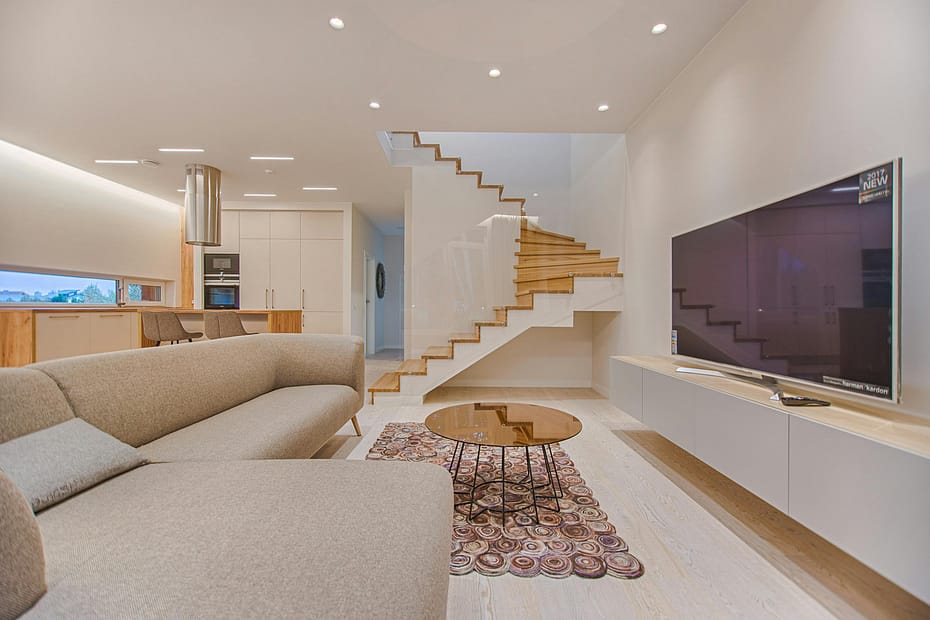Smart home technology has expanded beyond gadgets and gizmos to encompass sustainability efforts, comfort initiatives, and IoT applications. It now includes a diverse range of devices designed to seamlessly blend with a home’s overall design scheme, contributing to its aesthetic appeal. Innovations such as smart lighting and automated window treatments, alongside minimalist touchpad controls, play a significant role in enhancing a home’s visual allure.
Smart Furniture for Versatile Spaces
A pivotal aspect of intelligent interiors is smart furniture that serves dual purposes by providing functionality while enhancing the overall design. Examples include coffee tables equipped with wireless charging stations, sofas featuring integrated speakers, and modular furniture that adapts to different layouts. These pieces optimize space utilization while contributing to a modern, tech-savvy aesthetic.
Ambient Lighting as a Design Component
Smart lighting systems have evolved beyond mere illumination to become dynamic design elements that can alter a room’s ambiance with a tap on a smartphone. From color-changing LED strips to pendant lights with adjustable intensity, smart lighting enables homeowners to curate the mood and atmosphere of their spaces, adapting to various occasions and personal preferences.
Disguised Home Automation Systems
Automation systems, the brains behind smart homes, are now designed with aesthetics in mind. Touchscreen control panels can be seamlessly integrated into walls, resembling elegant artworks when not in use. This discreet approach ensures a sleek, uncluttered appearance while providing intuitive control over various aspects of home automation. Including climate and security.
Tailored Experiences through Personalized Design
Intelligent interiors excel in tailoring experiences to individual preferences. When thoughtfully integrated, smart home technology enhances personalization, ensuring that the design is aesthetically pleasing and functional for the inhabitants.
Customizable Ambient Displays
Activated smart mirrors displaying personalized information, such as weather updates and daily schedules, contribute to the customized aesthetic of intelligent interiors. These displays seamlessly blend into bathroom or vanity areas, effectively combining technology with daily utility.
Artificial Intelligence in Design
Artificial intelligence (AI) is revolutionizing interior design by analyzing user preferences, daily routines, and mood indicators to suggest design choices aligned with individual tastes. From recommending color palettes to suggesting furniture arrangements, AI ensures that the design resonates with the homeowner’s unique personality.
Voice-Activated Integration
Voice-activated assistants like Amazon’s Alexa or Google Assistant are seamlessly integrated into smart home ecosystems. Therefore, responding to voice commands to control lighting, temperature, or provide information. Their discreet presence adds sophistication to intelligent interiors.
Sustainability in Design
Intelligent interiors prioritize sustainability alongside aesthetics and convenience. Smart home technology plays a crucial role in creating eco-friendly living spaces that prioritize energy efficiency and environmental consciousness.
Smart Thermostats and Energy Management
Integrating smart thermostats into home design allows for precise control over heating and cooling systems, contributing to energy savings. These sleek devices complement modern interiors, emphasizing the fusion of style and sustainability.
Automated Window Treatments for Energy Efficiency
Smart window treatments regulate indoor temperatures and optimize natural light, contributing to energy efficiency. Programmable systems adjust based on the time of day, weather conditions, or user preferences, adding sophistication to window aesthetics.
The Future of Intelligent Interiors
The evolution of intelligent interiors is an ongoing journey with endless possibilities. As technology advances, the future promises seamless integration of smart home devices into design, augmented reality for design visualization, smart materials, enhanced connectivity, and interoperability.
The Synthesis of Beauty and Innovation
In conclusion, intelligent interiors represent the synthesis of beauty and innovation. Smart home technology is no longer an addition but an integral part of design language. From sleek smart furniture to personalized ambient displays, these innovations contribute to homes that are visually striking and responsive to inhabitants’ needs and preferences. The future holds the promise of homes that seamlessly blend aesthetics with cutting-edge functionality, reflecting the harmonious integration of technology into living spaces’ artistry.
More on INJ Architects:
